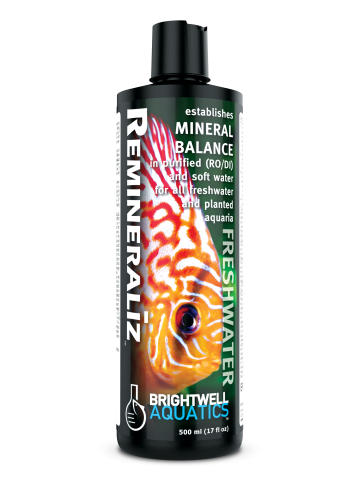Remineraliz-P
Provides Optimal Mineral Balance for Water that has been Purified
Overview
- Establishes an optimal mineral balance in water that has been purified (e.g. reverse osmosis, deionization, etc.) or is exceedingly-soft (e.g. well water in forested regions) for all freshwater planted and community aquaria, as well as for biotope aquaria housing fishes indigenous to forested and/or riverine habitats.
- Creates an ideal ratio of potassium, calcium, and magnesium, elements which are vital to the overall health of fishes, invertebrates, and aquatic plants; contains trace sodium and chloride for proper osmoregulation in plants and fishes.
- May be used to establish beneficial water parameters in aquaria filled with purified water, to replenish depleted mineral concentrations in aquaria that rarely receive a water change, and to re-establish proper water chemistry.
Sizes
- 250 g
- 500 g
- 1 kg
- 4 kg
- 20 kg
Technical Background
Fishes and aquatic plants and invertebrates require that specific elements be present in the water to aid with osmotic balance and ensure proper biochemical function, contributing to overall long-term health and survival. Remineralīz-P fulfills this requirement with a formulation based on data compiled from up-to-date aquatic research. Note that TDS and GH are not measuring the same ionic concentrations, and therefore they do not necessarily have a direct conversion; GH is related to the sum of divalent cations (e.g. calcium and magnesium) in solution, whereas TDS (total dissolved solids) measures the concentration of conductive substances in solution. This information is provided for reference purposes only.
Instructions and Guidelines
Consult a reference book listing the water chemistry requirements of the fishes and/or plants being maintained to determine the optimal range of GH and/or TDS. Remember to adjust pH and temperature of the water prior to adding it into an aquarium housing live organisms.
Determine GH and/or TDS in the aquarium prior to treating purified water with Remineralīz-P, then follow directions on opposite panel accordingly. Do not add this product directly to an aquarium without first diluting in water as directed.
When preparing water for a water change: For every 5 US-gallons of water to be changed, dissolve 2 grams of Remineralīz-P in purified water or tap water and mix thoroughly to dissolve. Assuming a starting GH and TDS of 0, this will result in an increase of ~2.7 dGH and ~60 ppm, respectively. When employed at this dosing rate, 500 g treats 1,250 US-gallons (4,732 L).
When preparing water for a new aquarium set up: Always adjust the water chemistry prior to adding live organisms to the aquarium. If setting up a planted aquarium and placing the plants into the substrate prior to completely filling the aquarium, adjust the GH, KH, pH, and temperature of the water in a separate vessel (e.g. in a large, clean pail or vat) before adding it to the aquarium. Do not add purified water to the aquarium and then attempt to adjust the water chemistry afterwards, as this will be stressful to the plants. Use the instructions below to calculate the amount of Remineralīz-P that will be required to bring about the desired change in GH or TDS to the volume of water to be used.
Advanced Instructions: Each gram of Remineralīz-P will increase the GH and TDS in 1 US-gallon of water by 6.7 dGH and 150 ppm, respectively. To obtain a specific GH and/or TDS value, divide the desired change in GH by 6.7 (or if TDS is preferred, divide the desired change in TDS by 150), then multiply this number by the net volume of water (in gallons) in the aquarium. Example: if the GH in 15 US-gallons is to be increased by 5 dGH, then add 11.2 g Remineralīz-P (5 ÷ 6.7 = 0.75 g per gallon; 0.75 g per gallon x 15 gallons = 11.2 g).
Caution: May cause eye or skin irritation. If in eyes, flush with water for 15 minutes, get medical attention. If on skin, wash thoroughly with water. Keep out of reach of children. Not for human consumption.
Ingredients
Sulfate salts of potassium, calcium, and magnesium, sodium chloride.
